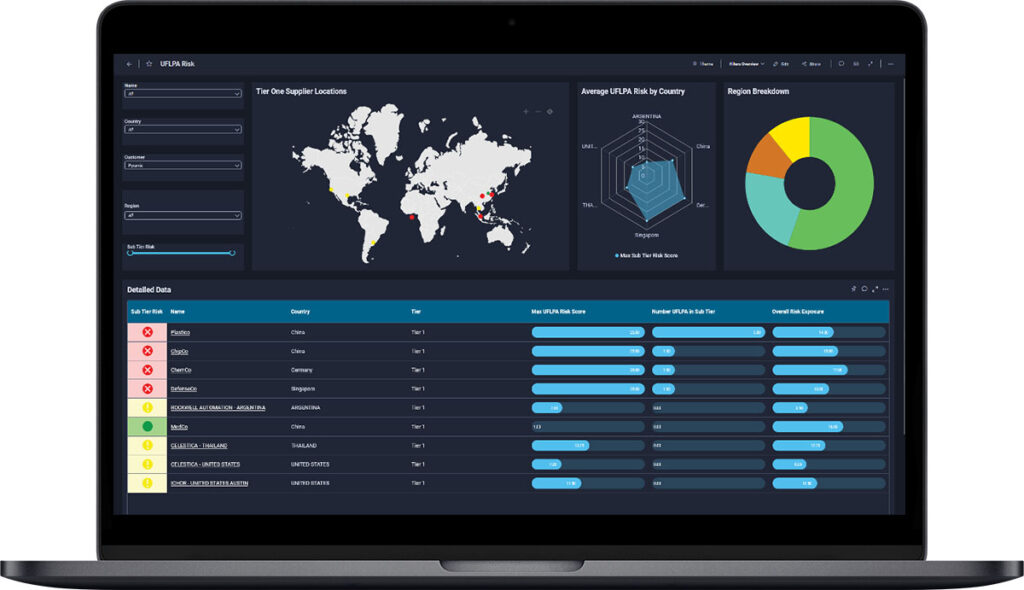UPDATE from July 9, 2024 – Additional sectors have been added to the list as they are identified with having a high-risk of involvement in Uyghur-related forced labor. Under the new enforcement rules, customs officials will begin prioritizing examinations of aluminum, polyvinyl chloride (PVC), and seafood shipments into the U.S. for any potential link to Xinjiang-related forced labor. Additional checks for cotton, tomatoes, and polysilicon-based products will also continue as these sectors remain classified as high-risk.
Surprisingly, many of the recent imports seized for links to forced labor aren’t coming directly from China, but from sub-tier suppliers in other countries. With risk buried that deep in global supply networks, companies looking to uncover those relationships for their UFLPA strategy will need to turn to technology for support. It’s simply impossible to peer that deep into the supply chain, especially when you have hundreds, if not thousands, of suppliers globally.
If your strategy is simply to wait for something to happen, that will be too late. Build a strong UFLPA strategy to avoid border seizures, shipment delays, fines, and devaluing your brand.
Why a UFLPA strategy is critical
Compliance with the Uyghur Forced Labor Protection Act requires companies to map multi-tier supply networks for ties to forced labor. Companies must identify whether any of their suppliers or sub-tier suppliers are listed on the UFLPA sanction list or have any connection to Uyghur forced labor. Not only do companies need to understand this risk now, they must also assess and monitor ongoing potential forced or child labor risk associated with each supplier.
Compliance is crucial because violations can lead to a range of penalties, including fines and reputational damage. Enforcing the Uyghur Forced Labor Protection Act, Customs and Border Protection officials have already blocked nearly $1B of imports.
To minimize risk and support a UFLPA compliance strategy, companies must have visibility into their entire multi-tier supply chain to identify any potential risk associated with forced labor in the Xinjiang Uyghur Autonomous Region.
Ignorance is no longer an excuse. U.S. companies are increasingly being held legally responsible for their suppliers’ practices, and they’ve always been tarnished by sub-tier mismanagement in the public eye.
Challenges of building a UFLPA strategy
At Everstream, we work with the world’s largest companies operating the most complex supply networks. Typically, our clients have thousands, even tens of thousands global suppliers. When it comes to implementing a new strategy for compliance, we commonly see global companies facing three big challenges.
- Stakeholders don’t have access. Supply chain managers can’t pierce the veil into their extensive sub-tier supply network. Gaining visibility into the sub tier can be very challenging, even with technology support.
- Operating at scale. Companies this size can’t look one at a time for UFLPA risk, they need a plug-and-play solution that can scale. And it must run on a continual basis, constantly monitoring.
- UFLPA Chain of Custody Requirements. Various stakeholders need easily accessible information on-demand that can be used to cover UFLPA Chain of Custody requirements – including evaluating, exploring, reporting and analysis.
Clearly, human staff alone can’t meet these requirements. Supply chain risk management software can, but not all software platforms help with UFLPA compliance. The right platform should support your UFLPA strategy every step of the way.
4 steps for your UFLPA strategy
These are the four steps that companies should take to build a strong UFLPA strategy. Each step has opportunities to lean on software for automation and scalability:
Step 1: Identify known Tier-1 suppliers with high UFLPA risk
Today’s supply chain risk management technology can provide visibility into specific risks for an entire supply network. Today’s artificial intelligence and machine learning algorithms can quickly analyze a supplier network and create a comprehensive picture of various risks that are important to an organization. Technology can provide critical information such as who is supplying what product, who oversees production and shipping, and what the UFLPA compliance status of each supplier is.
It may sound obvious, but not all platforms monitor all risks. And not all government lists thoroughly document the full extent of forced labor relationships. Make sure that one of the risks your platform can monitor is forced labor.
At Everstream, we built out our own expanded UFLPA watch list, starting with the companies on the U.S. government published list. But once our researchers dug in, we found many other connections and our list is constantly expanding. Our experts look carefully for aliases, subsidiaries, corporate relationships, and suppliers with other locations in high-risk areas.
Step 2: Analyze the sub-tier supplier network ties and product flows to comprehend the full scope of UFLPA risks
Tier 1 mapping is a good start, but companies must map their entire sub-tier network to uncover the level of risk that U.S. Customs and Border Protection are identifying.
At Everstream, we take our full list and then we build the sub-tier connections. Who are their customers? Who are their customers’ customers? That creates what we call our “expanded watch list.”
This process is largely automated using Everstream Discover – our multi-tier, automated, AI-based software that uncovers connections and risk not only at the supplier but the location and the product level as well.
Ultimately, it’s a very rich and sophisticated platform for reporting analytics and incident monitoring. This capability enables companies to connect the dots both upstream and downstream from the watch list members.
Step 3: Prioritize the highest-risk suppliers
Companies need the ability to assess UFLPA risks and prioritize the highest-risk connections for mitigation. This is a deep issue, so nobody will be able to fix everything at once, but you can prioritize. You can also document the mitigation steps you’re taking to share those with stakeholders or to enhance your UFLPA strategy. This is the risk assessment approach.

Figure 1: Risk scoring metrics on a customizable dashboard help support a strong UFLPA strategy.
Risk assessment strategy prioritization is impossible without risk-scoring metrics. Everstream’s sophisticated matching algorithm not only identifies forced-labor connections, it also creates a risk priority score for each one. Supply chain managers can then sort suppliers, locations, and products based on their risk scores, drill down into the platform for further details, then make plans to discuss problems with suppliers or seek out alternate partnerships.
Step 4: Monitor the supply network and sanctioned parties lists for any updates or changes
A UFLPA strategy isn’t a one-time effort. Because operations are always shifting, companies must constantly monitor forced labor risk throughout the supply network.
Technology can be used to create alerts when Uyghur-related incidents occur so that companies are immediately aware of changes in UFLPA risk levels and take immediate action. To make this information useful, companies need flexible analytics and reporting. For example, some companies may want database spreadsheets, others may want complex analytics, dashboards, or reports.
The right software platform will offer options, and include detailed information about each entity within the network, including their UFLPA status, description of products and services they provide, and any geographic restrictions.
Everstream’s dashboard provides links to UFLPA lists, and allows users to view product flows and lanes associated with these relationships so that they can gain insight into physical routes of goods as well as types of products that are being shipped.
Ongoing UFLPA strategy
To create a comprehensive and effective UFLPA strategy, managers will need to rely on technology to fully identify UFLPA-related risk in their supply chains quickly and accurately. AI-powered platforms also support mitigation measures such as additional compliance checks on high-risk suppliers, or changing suppliers entirely if forced labor is detected.
This can be as simple as one dashboard displaying network tiers, relationships between suppliers, product flows, and UFPL sanctions party lists. This enables managers to easily identify “needles in the haystack” to address UFLPA compliance issues. With this comprehensive view of UFLPA compliance risks, supply chain managers can be confident that they are mitigating potential Uyghur forced labor threats.
Watch our webinar to see a demo of UFLPA strategy software in action
